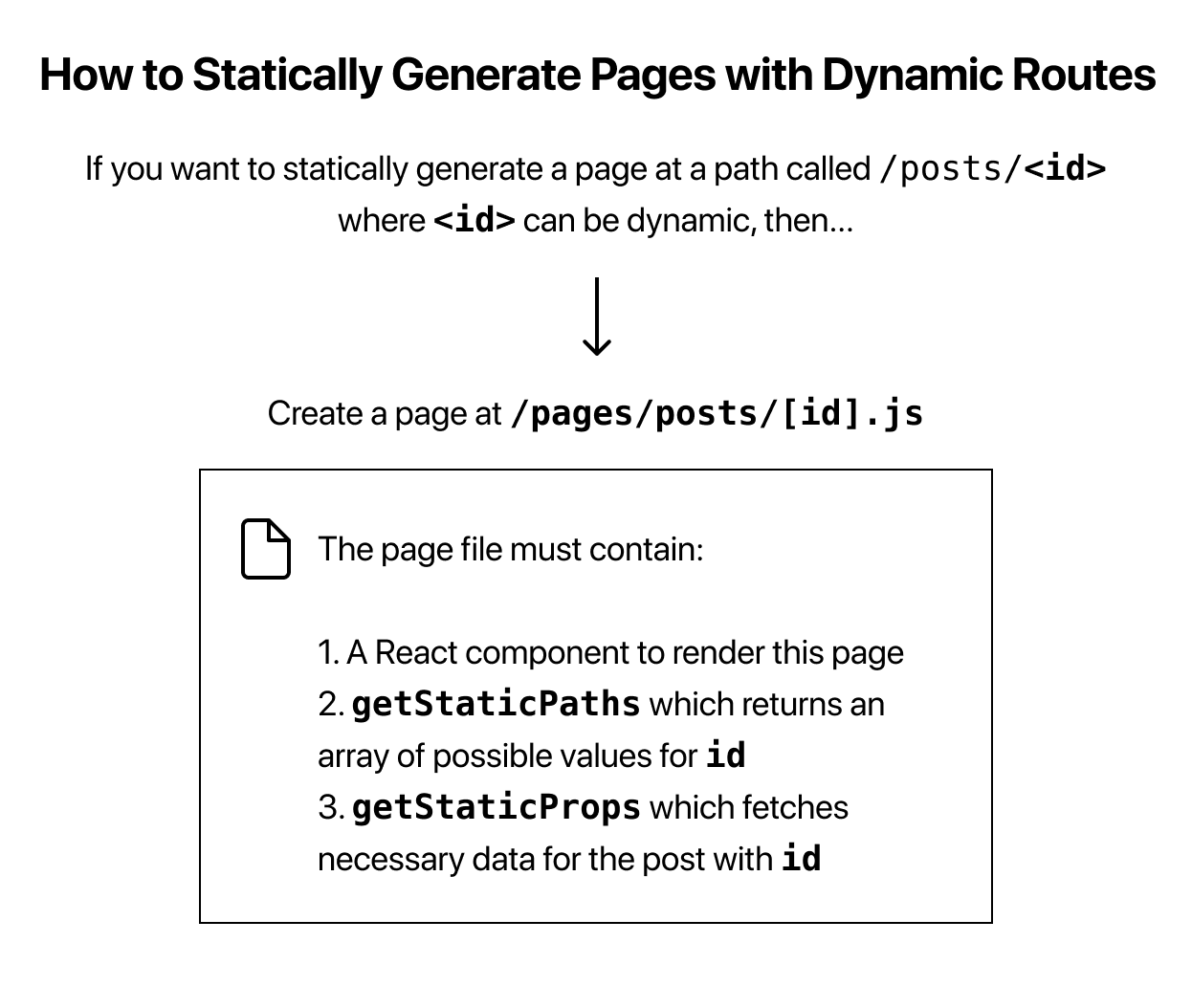npx create-next-app nextjs-blog --use-npm --example "https://github.com/vercel/next-learn/tree/master/basics/dynamic-routes-starter"
In pages/posts/[id].js, we’ll write code that will render a post page — just like other pages we’ve created.
import Layout from '../../components/layout'
export default function Post() {
return <Layout>...</Layout>
}
We’ll export an async function called getStaticPaths from this page. In this function, we need to return a list of possible values for id.
import Layout from '../../components/layout'
export default function Post() {
return <Layout>...</Layout>
}
export async function getStaticPaths() {
// Return a list of possible value for id
}
import Layout from '../../components/layout'
export default function Post() {
return <Layout>...</Layout>
}
export async function getStaticPaths() {
// Return a list of possible value for id
}
implement getStaticProps again - this time, to fetch necessary data for the blog post with a given id. getStaticProps is given params, which contains id (because the file name is [id].js).
import Layout from '../../components/layout'
export default function Post() {
return <Layout>...</Layout>
}
export async function getStaticPaths() {
// Return a list of possible value for id
}
export async function getStaticProps({ params }) {
// Fetch necessary data for the blog post using params.id
}
First, let’s set up the files:
- Create a file called [id].js inside the pages/posts directory.
- Also, remove first-post.js inside the pages/posts directory — we’ll no longer use this.
- open lib/posts.js again and add the following getPostData function at the bottom. It will return the post data based on id:
export function getPostData(id) {
const fullPath = path.join(postsDirectory, `${id}.md`)
const fileContents = fs.readFileSync(fullPath, 'utf8')
// Use gray-matter to parse the post metadata section
const matterResult = matter(fileContents)
// Combine the data with the id
return {
id,
...matterResult.data
}
}
- open pages/posts/[id].js and replace this line:
import { getAllPostIds } from '../../lib/posts'
import { getAllPostIds, getPostData } from '../../lib/posts'
export async function getStaticProps({ params }) {
const postData = getPostData(params.id)
return {
props: {
postData
}
}
}
- Post component to use postData. In pages/posts/[id].js replace the exported Post component with the following code:
export default function Post({ postData }) {
return (
<Layout>
{postData.title}
<br />
{postData.id}
<br />
{postData.date}
</Layout>
)
}
To render markdown content, we’ll use the remark library,install it:
npm install remark remark-html
Then, open lib/posts.js and add the following imports to the top of the file:
import { remark } from 'remark'
import html from 'remark-html'
- And update the getPostData() function in the same file as follows to use remark:
export async function getPostData(id) {
const fullPath = path.join(postsDirectory, `${id}.md`)
const fileContents = fs.readFileSync(fullPath, 'utf8')
// Use gray-matter to parse the post metadata section
const matterResult = matter(fileContents)
// Use remark to convert markdown into HTML string
const processedContent = await remark()
.use(html)
.process(matterResult.content)
const contentHtml = processedContent.toString()
// Combine the data with the id and contentHtml
return {
id,
contentHtml,
...matterResult.data
}
}
- update getStaticProps in pages/posts/[id].js to use await when calling getPostData:
export async function getStaticProps({ params }) {
// Add the "await" keyword like this:
const postData = await getPostData(params.id)
// ...
}
- update the Post component in pages/posts/[id].js to render contentHtml using dangerouslySetInnerHTML:
export default function Post({ postData }) {
return (
<Layout>
{postData.title}
<br />
{postData.id}
<br />
{postData.date}
<br />
<div dangerouslySetInnerHTML={{ __html: postData.contentHtml }} />
</Layout>
)
}
- add an import for next/head at the top of the file and add the title tag by updating the Post component:
// Add this import
import Head from 'next/head'
export default function Post({ postData }) {
return (
<Layout>
{/* Add this <Head> tag */}
<Head>
<title>{postData.title}</title>
</Head>
{/* Keep the existing code here */}
</Layout>
)
}
To format the date, we’ll use the date-fns library. First, install it:
npm install date-fns
import { parseISO, format } from 'date-fns'
export default function Date({ dateString }) {
const date = parseISO(dateString)
return <time dateTime={dateString}>{format(date, 'LLLL d, yyyy')}</time>
}
Open pages/posts/[id].js, then add an import for the CSS file, and replace the Post component with the following code:
// Add this import at the top of the file import utilStyles from '../../styles/utils.module.css'
export default function Post({ postData }) {
return (
<Layout>
<Head>
<title>{postData.title}</title>
</Head>
<article>
<h1 className={utilStyles.headingXl}>{postData.title}</h1>
<div className={utilStyles.lightText}>
<Date dateString={postData.date} />
</div>
<div dangerouslySetInnerHTML={{ __html: postData.contentHtml }} />
</article>
</Layout>
)
}
- On your personal GitHub account, create a new repository called nextjs-blog.
- The repository can be public or private. You do not need to initialize it with a README or other files.
Create_a_Vercel_Account import nextjs-blog repository on Vercel.use
You’ll need to Install Vercel for GitHub. You can give it access to All Repositories. Once you’ve installed Vercel, import nextjs-blog.

